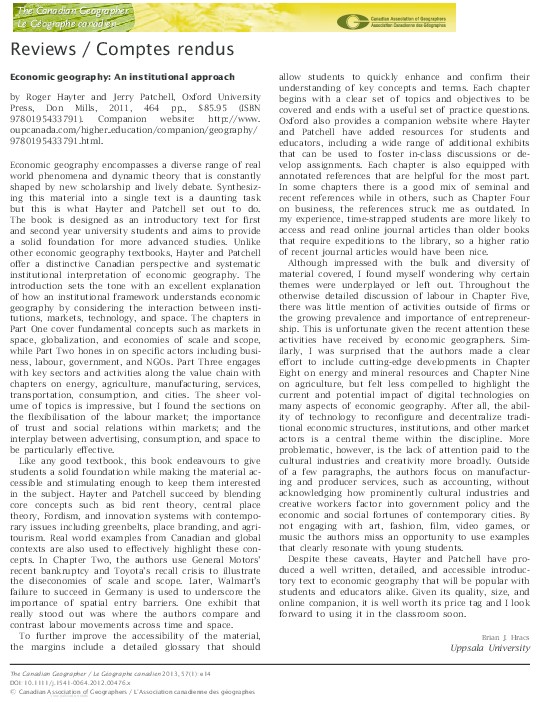Academia.edu no longer supports Internet Explorer.
To browse Academia.edu and the wider internet faster and more securely, please take a few seconds to upgrade your browser.
Economic Geography: An Institutional Approach (Book Review)
Economic Geography: An Institutional Approach (Book Review)
Canadian Geographer / Le Géographe canadien
Related Papers
2005 •
2008 •
Hrvatski geografski glasnik/Croatian Geographical Bulletin
The Institutional Approach in Economic Geography: an Applicative View2011 •
The paper opens with a statement on the social embeddedness of knowledge. The disciplinary situation and practices of economic geographers are reviewed in the light of this statement. The rise of a new geographical economics is noted, and its main thrust is summarized in terms of a description of the core model as formulated by Krugman. The geographers’ reception of the new geographical economics is described, and some key aspects of this reception are assessed. I then subject the core model itself to critical evaluation. Its claims about pecuniary externalities in the context of chamberlinian competition provide a number of useful insights. However, I argue that the model is deficient overall in the manner in which it tackles the central problem of agglomeration. The discussion then moves on to consideration of the recent interest shown by many economic geographers in issues of culture. After a brief exposition of what this means for economic geography, I offer the verdict that this shift of emphasis has much to recommend it, but that in some of its more extreme versions it is strongly susceptible to the temptations of philosophical idealism and political voluntarism. In the final part of the paper, I attempt to pinpoint some of the major tasks ahead for economic geography in the phase of post-“late capitalism.” I suggest, in particular, that a new cognitive map of capitalist society as a whole is urgently needed, and I offer some brief remarks about how its basic specifications might be identified.
Over the last twenty years, modern economic geography has been increasingly fragmented, particularly concerning its themes, on the one hand, and its schools of thought, perspectives and paradigms, on the other. Although there have been arguments in favor of engaged pluralism between the latter, what we see in reality is mainly fragmented pluralism, which is particularly problematic for the identification with the sub-discipline and the exchange with neighboring social disciplines. In order to solve this problem, in our view, we need an Integrative Paradigm of Economic Geography. In this paper, we sketch the contours of such a paradigm, which consists of a core, namely economic activities in space, place and scales and their drivers, and three inter-related ontological foundations, namely networks, evolution and institutions.
This is an introductory course in Economic Geography. This course examines how factors of production like land, labor and capital; economic activities like consumption, trade, production, investments; and institutions like state, markets and corporations alter economic space. With globalization, these processes acquire greater intensity producing cultural impacts like “MacDonaldization,” environmental impacts like waste dumping, and political impacts like weakening of the nation-state. Economic geography makes sense of these changes by understanding how economic processes work, how they change spaces, and how they differentially impact the global North and the South.
RELATED PAPERS
Darul Harb Fetvaları
Dâru'l Harb Hudûdlarında Oy/Rey Vermenin Hükmü Nedir?2024 •
Ciudadanìas diferenciadas en un Estado Multicultural
Dilemas en la construcciòn de ciudadanias diferenciadas en un espacio multicultural: El caso de Oaxaca.2005 •
RECIMA21 - Revista Científica Multidisciplinar - ISSN 2675-6218
Alterações Na NR-10 e Os Serviços Com Eletricidade2021 •
Encyclopedia of Data Warehousing and Mining, Second Edition
Soft Subspace Clustering for High-Dimensional DataSistemi upravlìnnâ, navìgacìï ta zvʼâzku
Foundation of the Factors Affecting the Planning and Management of the Radioelectronic Development2019 •
Journal of Nondestructive Evaluation
Nondestructive Porosity Assessment of CFRP Composites with Spectral Analysis of Backscattered Laser-Induced Ultrasonic Pulses2013 •
Journal of Nuclear Cardiology
Accuracy of PET/CT for detection of infective endocarditis: Where are we now?2017 •
Bulletin of "Carol I" National Defense University
The chinese vision of soft power. General considerations2023 •
Balıkesir Sındırgı Çatı Tamiri Ustası İzolasyonu 0506 337 17 10
Balıkesir Sındırgı Çatı Tamiri Ustası İzolasyonu 0506 337 17 102015 •
Proceedings of the International Conference on Industrial Engineering and Operations Management
Assessment of Ergonomic Risk Factors Affecting the Musculoskeletal Discomfort of Daycare Centers Occupants in the PhilippinesInternational Conference on Eurasian Economies 2017
The Role of Women on the Economic Development as the “Secondary” Production Factor: An Analysis on Nuts-22017 •

 Brian Hracs
Brian Hracs